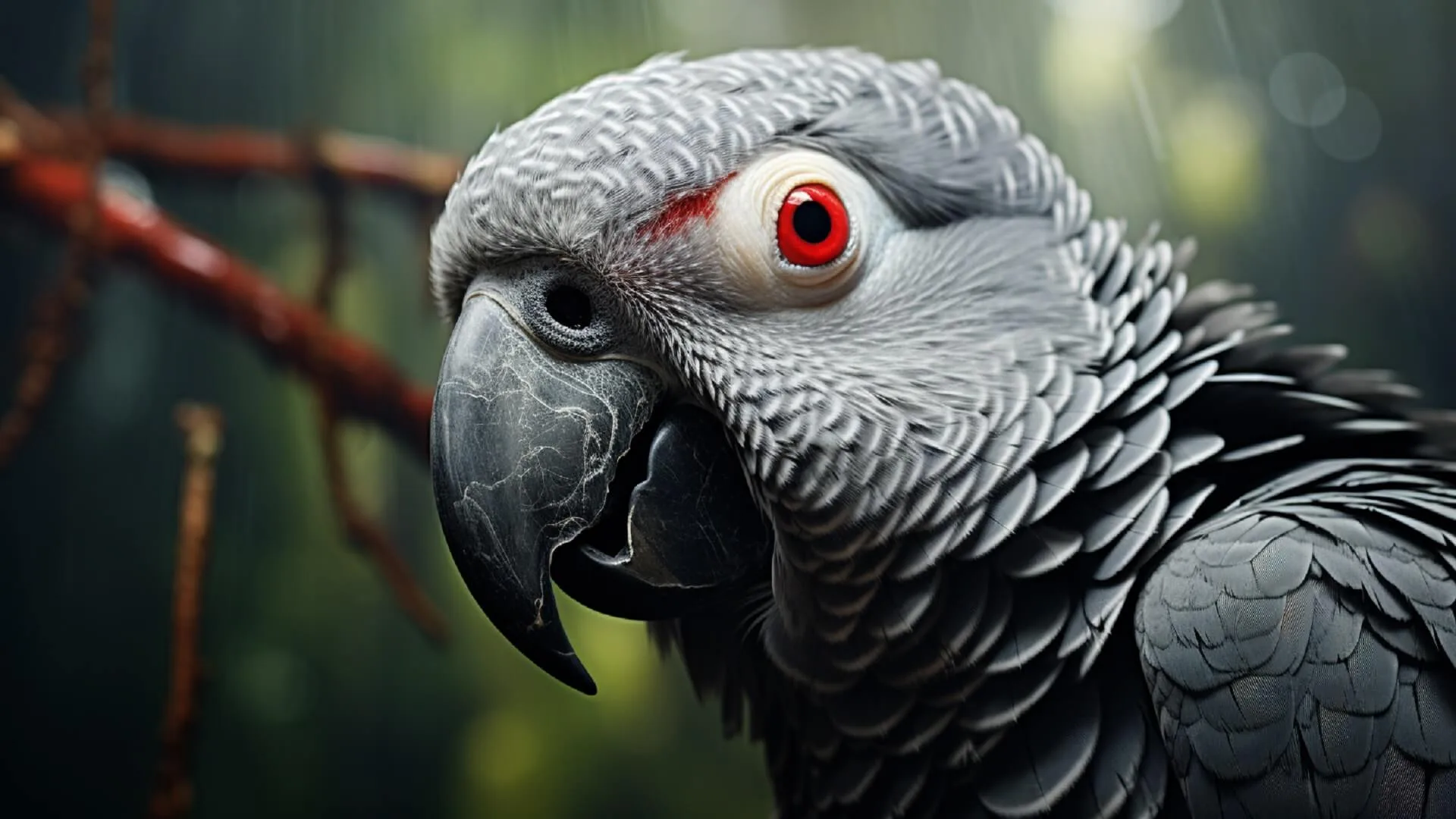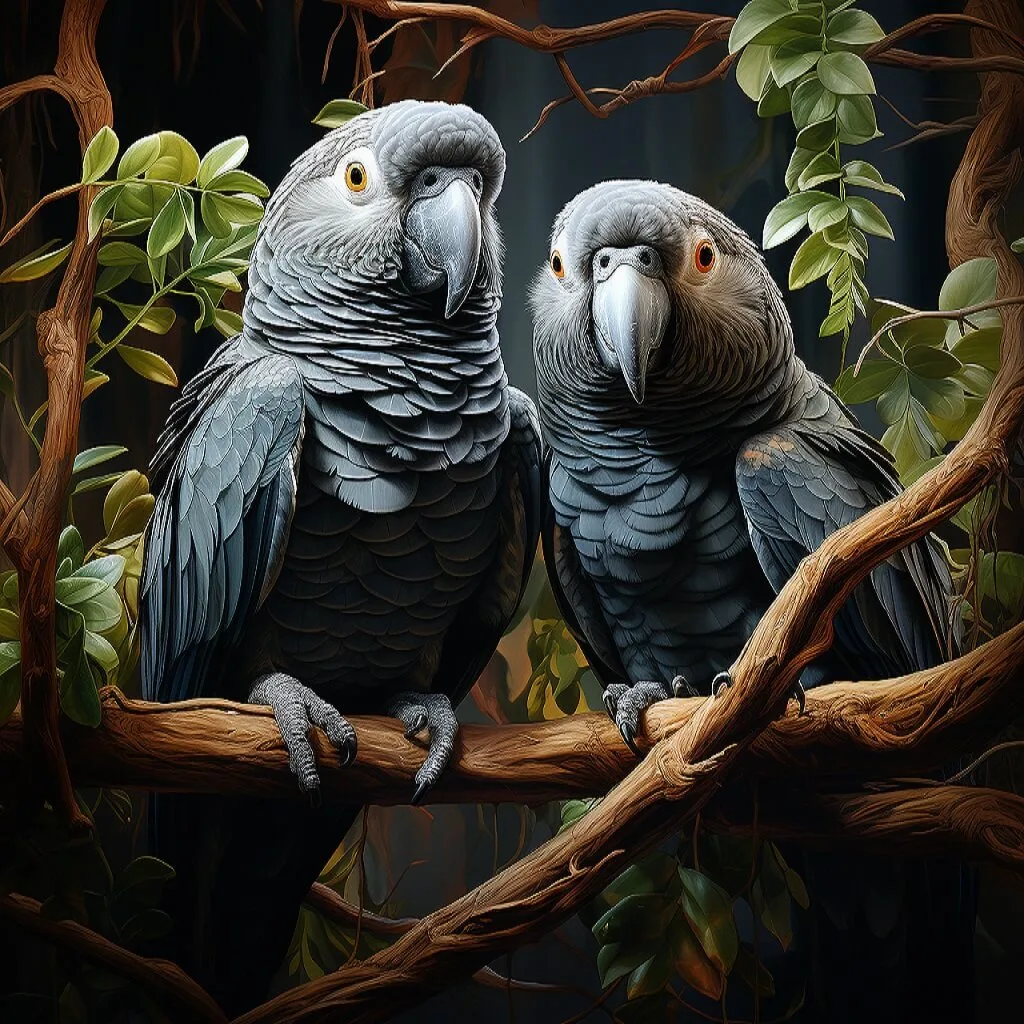
Psittacus refers to a family of African grey parrots, a part of the Psittacinae subfamily, which includes two unique members: the grey parrot and its cousin, the Timaneh parrot.
For a long time, everyone thought of these two as variations of the same bird family, with the grey parrot as the standard and the timaneh as a kind of special version. But in 2012, experts at BirdLife International noticed such differences in their DNA, appearance, color and chirping that they were declared separate species.
These parrots are home to the lush rainforests of West and Central Africa, where they are known for their brilliant brains. Their diet is a colorful mix of palm nuts, seeds, fruits and greenery, although they are not above eating a snail or two. Their habit of imitating human speech and sounds has made them beloved companions and have found their way into the hearts and homes of people around the world.
Origin
In 1758, Swedish scientist Carl Linnaeus first used the name Psittacus for a group of birds in his book “Systema Naturae”. Psittacus means “parrot” in Latin. Linnaeus placed all 37 species of parrots known at that time in this group. Of these, the grey parrot (Psittacus erithacus) was chosen by George Robert Grey as the main example of the group.
Species
In the bird family, there are mainly two members that stand out:
- First, we have the Grey parrot, which people also call the Congo grey, African grey, or Congo African grey parrot (scientifically named Psittacus erithacus, or previously Psittacus erithacus erithacus). Imagine a bird about the size of a ruler (33 cm or 13 inches long), wearing a coat of light-grey feathers, sporting a cherry-red tail, and boasting an all-black beak. Youngsters of this species start life with a slightly different look—tails with a less shiny, darker red at the end and grey eyes that change to pale yellow by their first birthday. These parrots enjoy their life on the islands of Príncipe and Bioko and have a wide home range that stretches from the southeastern Ivory Coast all the way to northern Angola, making a stop in several countries along the way. In the world of bird lovers, this parrot is affectionately known as a “CAG.”
- Then, there’s the slightly smaller sibling, the Timneh parrot or Timneh African grey parrot (scientifically Psittacus timneh, previously Psittacus erithacus timneh). Picture a bird that’s a bit shorter than the Grey, with a deep charcoal grey dress, a darker maroon tail, and a unique light, horn-colored beak top. These birds have their own exclusive spots in the lush Upper Guinea forests and neighboring savannas of West Africa, making homes from Guinea-Bissau to Ivory Coast. Known as “TAG” among friends, Timnehs are known for picking up speech a bit earlier than their Grey cousins, growing up just a tad quicker. They’re also rumored to be the more outgoing type, less likely to shy away from new faces or places, though that’s a bit of a friendly debate among parrot enthusiasts. In 2012, the Timneh parrot earned its spotlight, being recognized as its own species and marked as vulnerable.
While some bird enthusiasts dream of discovering or recognizing more members within this feathery family, science currently only has eyes for these two.
Behavior and ecology
Breeding
Grey parrots form pairs for life and build their nests in tree cavities. The female lays 3 to 5 eggs and incubates them for about 30 days, during which time her partner feeds her. Young birds leave the nest when they are about 12 weeks old. We don’t know much about how these birds mate with each other in the wild.
Longevity
Like many large parrots, grey parrots can live a long time. According to the Animal Aging and Longevity Database, the oldest grey parrot kept in captivity with evidence lived to almost 50 years. There are stories of brown parrots living to be 73 and even 93 years old in captivity. The World Parrot Trust says that in captivity a grey parrot can live between 50 and 60 years. The Guinness Book of World Records also cites a brown parrot that reportedly lived for 72 years in captivity as the oldest known example of this species.
Illness and disease
Grey parrots, scientifically known as Psittacus erithacus, sometimes get a type of lung problem called lipid pneumonia, which is not caused by any infection. This lung problem occurs when there is too much fat in the lungs and can come from outside or from breathing in the body’s own fat. When a grey parrot has this problem, its lungs become hard and brown. This disease is not just in parrots; Other animals get it too. Brown parrots also often do not drink enough water and scientists have studied their blood to learn more about this dehydration. They may also develop heart problems from an early age, especially if their parents are very close relatives, showing symptoms such as weakness and trouble walking properly.
Another serious disease that they can contract is the Beak and Feather Disease Virus, which is very contagious and can be fatal, which can affect their feathers and beaks. Research has also found that grey parrots can be infected with chlamydiosis, a disease that affects birds, through a study that tested several birds and found some new types of bacteria that cause it. Are made. Finally, these parrots may suffer seizures because they do not have enough calcium in their diets, which affects their balance and can cause other nerve problems. This usually happens in birds between 2 and 15 years of age.
Intelligence
Birds, particularly African grey parrots, show behavior, brain function, and brain structures that are similar to those found in humans, suggesting that they may experience consciousness similar to humans. This observation points to a fascinating example of parallel evolution, where different species independently evolve similar traits.
Unlike other parrots, wild grey parrots have been documented imitating the sounds of several other species
Irene Pepperberg’s studies with captive grey parrots, particularly one named Alex, have proven that these birds can understand simple human words and their meanings, and can recognize shapes, colors, numbers, and even Can use complex ideas like the concept of zero. According to Pepperberg and other bird experts, grey parrots can perform many of the same brain functions as dolphins, chimpanzees and small children. Alex the parrot can not only name things but also say what he wants, showing that grey parrots can tell the difference between things and their feelings. Overall, it has been found that grey parrots learn quite quickly, but their thinking is mostly linear and not about abstract ideas. They can figure things out with their minds, but like monkeys, not all grey parrots are equally smart. For example, in a test where food was hidden at the bottom of a cup, grey parrots could more often find the food if they initially looked where it was hidden.
Pet grey parrots can begin to speak in their first year, but typically, they say their first words between 12 and 18 months of age. The Timneh subspecies often begins to speak slightly earlier, sometimes even before they are one year old. Both types of grey parrots can learn to speak like humans, but how well and how much they speak can vary greatly from bird to bird. Grey parrots are also known to make specific sounds when they see different types of animals approaching, which suggests that they are reacting to specific things with their vocalizations.
In 2011, Delilah Bovet and her team at Paris West University Nanterre La Défense discovered that grey parrots can actually work well together. He conducted experiments and observed that these parrots could solve puzzles to get food. For example, two parrots learned to pull a string at the same time to get a treat. In another test, one parrot would step on something to pull out a tray full of food, and the other would pull the tray closer so they could both eat. Researchers observed that parrots would wait for each other to do their work so that they could work together properly. Additionally, the parrots had their own favorite companions with whom they liked to team up for these tests.
In a study with grey parrots, they placed food in the bottom of two cups where everyone could see. Then, a person picked up a cup, sometimes taking out whatever was underneath it, and sometimes putting the cup back without taking anything. They did this with different cup orders and by moving the food differently each time. The parrots didn’t just remember which cup to put the food in; He liked the cup that was touched last.
Many tests were conducted to see how smart grey parrots are. Typically, animals cannot associate sounds with objects, such as food hidden in a cup. It was previously thought that only great apes and small children could do this. But, these tests showed that grey parrots can also do this in most situations. If a cup with food was shaken back and forth, the parrots were better at choosing the correct cup. However, more tests showed that it was not necessary to shake the cup to find the food. This means that brown parrots are very smart.
Vocalisation
Imagine having a grey parrot as a friend who is not just anyone’s friend but a mimic master! This feathered friend can whistle, click and replicate all kinds of household sounds, turning your home into a live orchestra. Imagine your parrot playfully imitating the sound of a microwave beeping, your phone ringing, or even water dripping from a faucet. These clever birds don’t stop here; They’re like little sponges, soaking up every sound around them, including the chirping of wild birds or the beeping of your video game. And let’s not forget, if they catch you saying something spicy, don’t be surprised to hear it echoed even when you’ve forgotten about it. Grey parrots also show their smart side by recognizing and imitating the voices of different people, which further adds to their charm. Plus, they are always alert, using special calls to alert you about various dangers, proving that they are not just about fun and games but also care about safety. Owning a brown parrot means having a home full of unexpected sounds and lots of laughter.
In an experiment with brown parrots reared in a space created for them, there were four parrots. They had toys to play with and often saw people who cared for them. The sounds around them included birdsong, cleaning noises and doors creaking. Over three years, these parrots made more than 50,000 sounds. What was revealed was that even though they had grown up in this place, they did not imitate the sounds they heard there. They also made calls similar to other brown parrots living in different places, including wild parrots.
Status and conservation
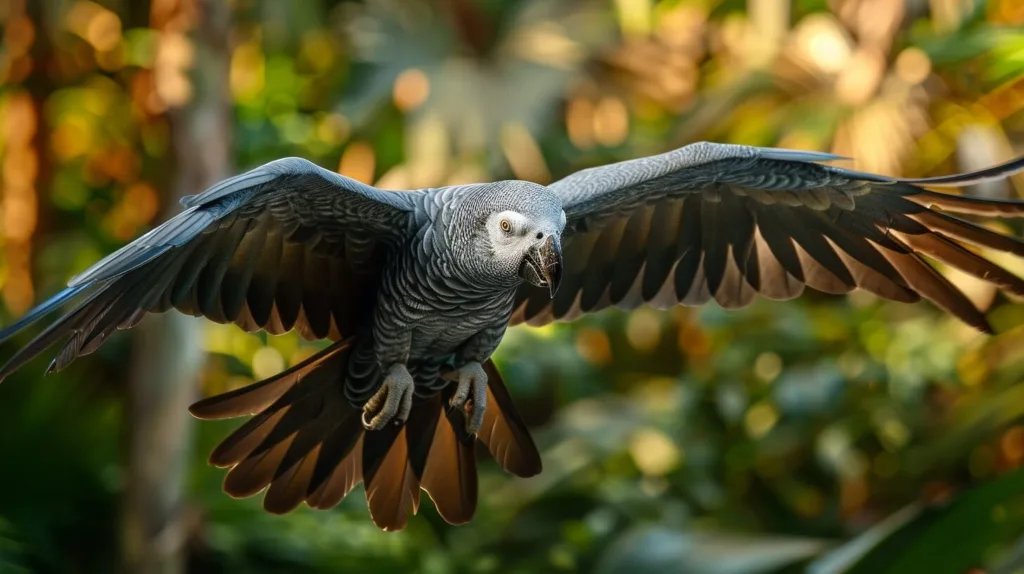
Grey parrots were previously considered common, but we now know they are at greater risk. In 2007, they were listed as near threatened, and by 2012, their status had deteriorated to vulnerable. This change is because up to 21% of them may be taken from the wild each year, mainly for pets. These birds live only in the rainforests of West and Central Africa, where they need old, large trees for nesting. However, the trees they use are also those that people want for lumber. Therefore, as the forests become smaller, the number of brown parrots also decreases.
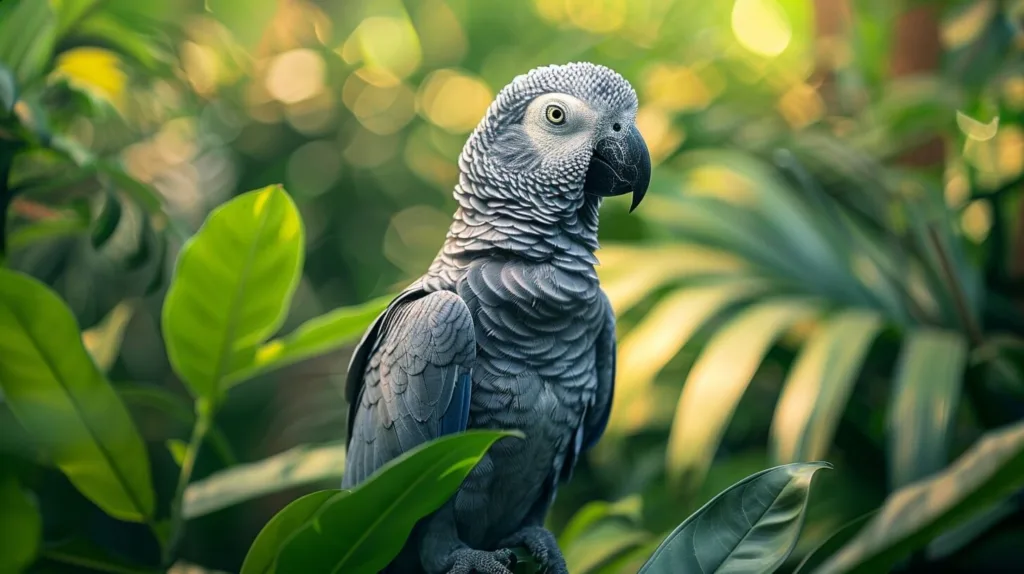
The grey parrot comes under a worldwide regulation called CITES that takes care of endangered animals and plants. This rule ensures that countries properly vet when grey parrots are shipped out, with the correct paperwork, and confirm that selling them does not harm their wild friends. Between 1994 and 2003, large numbers of grey parrots, more than 350,000, were shipped worldwide, making them one of the most traded birds. But their numbers kept falling due to excessive trade and illegal deals. So, in 2004, the people in charge decided to shed light on the grey parrot trade. They recommended stopping the sale of grey parrots in some places and agreed that it was time to plan for better care of these feathered friends.
In the US, there has been a rule since 1992 that basically says, “No, you cannot bring wild grey parrots into the country.” It’s all about keeping those birds free and not in cages at someone’s house. And Europe? They are on the same page. Since 2007, they have refused to import any wild birds to sell as pets. It seems as if both places are saying, “Let’s leave wild birds where they belong, rather than making them a part of our home decor.”
Relationship with humans
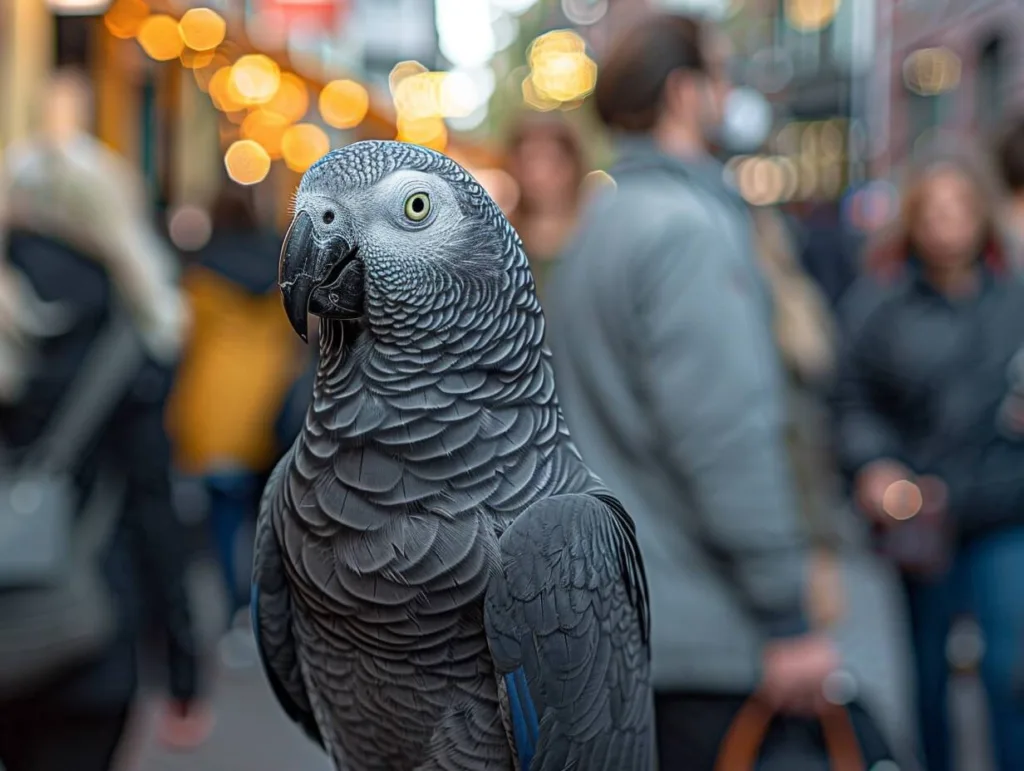
Aviculture
These smart birds make great pets and friends. People who have parrots like them very much. But, because they are so smart, they need their owners to spend a lot of time with them and let them out of their cage often. They need to be kept busy with toys and attention, otherwise they may get upset and hurt themselves. They need a large cage, a variety of food including fresh, and lots of toys that they can chew on safely. Without these things, they may start to misbehave and even get sick with problems like pulling out their feathers, which are difficult to fix.
Even the best-cared-for, happiest pet parrot will make a lot of mess and noise. Most parrots are not actually domesticated, and even those that are friendly, hand-reared, and come from aviaries are only a generation or two away from their wild ancestors. Despite this, people have long kept these parrots as pets, including the ancient Greeks, wealthy Romans, King Henry VIII, and Portuguese sailors.
FAQs
Q: How are grey and Timneh parrots different from each other?
Imagine two siblings with their own unique characteristics: the grey parrot is larger, with a sleek light grey suit and a striking cherry-red tail, while the Timneh is smaller, with a dark charcoal grey and maroon tail. He also has his own favorite places in Africa, where he likes to visit.
Q: What is the life expectancy of an African grey parrot?
These feathered friends can be a part of your life for a long time, almost like a lifelong companion. With proper care, they can celebrate up to 50-60 birthdays with you, and sometimes, they even live beyond their expected years, reaching 93 – talk about a lifelong friendship!
Q: What do African grey parrots eat?
Imagine a gourmet foodie who loves a little bit of everything. Palm nuts, seeds, fruits and even the occasional snail make up their colorful buffet. For those of us staying at home, it’s as if they have their own salad bar, where fresh fruits and vegetables are always on the menu.
Q: Are our feathered brown friends in danger?
sadly yes. Their homes are disappearing, and many have turned to the pet trade. They are like the local people of the forest, and without our help in protecting their homes and keeping them safe in the wild, we risk losing their songs forever.
Q: Can they really talk like us?
Absolutely! These birds are not just imitators; They are part of the conversation. With correct association, they don’t just repeat words; They understand and communicate, making them incredibly special housewives who bring a unique blend of interaction and charm to our lives.
Q: What health problems should I pay attention to?
Like any friend, we want them to be healthy and happy. Their lungs may get cold, they may experience heart problems, or they may even become a little too thin if they don’t drink enough water. Keeping an eye on them and giving them the care they need can help them live their best life.
Q: What does it take to keep an African grey parrot happy at home?
Imagine you’re creating a little paradise for a highly intelligent friend. They need space to explore, a variety of snacks to entertain their palates, and lots of love and attention. It’s like setting up a playroom that keeps them mentally stimulated and physically active, ensuring that they are always happy and never bored.
